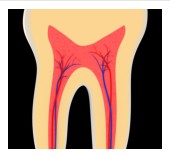Pulp Therapy (for baby teeth)
The pulp of a tooth is the inner, central core of the tooth and contains
blood vessels and nerves. Dental caries (cavities) and trauma to the tooth are
the primary reasons for children to undergo pulp therapy.

Your child may need pulp therapy if he/she has
- Tooth pain for no apparent reason
- A tooth that is sensitive to temperature
changes
- A broken tooth
The main purpose of pulp therapy
is that the tooth is not lost. Primary teeth are needed for chewing and speaking
and serve as space savers for permanent teeth. Without the primary teeth to
guide them, existing neighboring teeth can crowd in, causing permanent teeth to
grow in crooked or tilted.
The two forms of pulp therapy for children's teeth
are: vital pulp therapy for primary teeth (pulpotomy) and non-vital pulp therapy
for primary teeth (pulpectomy).
Vital Pulp Therapy for Primary (Baby) Teeth
Vital pulp therapy is for cases in which the tooth’s pulp may be salvaged.
The main purpose is to maintain and protect existing healthy pulp by removing
the diseased pulp tissue within the crown portion of the tooth. Next, an agent
is placed to prevent bacterial growth and to calm the remaining nerve tissue.
This is followed by a final restoration (usually a stainless steel crown).
Non-Vital Pulp Therapy for Primary (Baby) Teeth
Non-vital pulp therapy is required when the entire pulp is diseased
(into the root canal(s) of the tooth). During this treatment, the
diseased pulp tissue is completely removed from all parts of the tooth.
The canals are cleansed and filled with a special material meant to be
naturally absorbed by the body while the root prepares for the primary
tooth to fall out and be replaced by a permanent tooth. A crown is
placed on the tooth to prevent fractures.
If the pulp is severely damaged
then your doctor may recommend removing the tooth entirely. If this is a case
ask if space maintainers are necessary for future development.
If you live in or around Elmhurst and you suspect
your child is in need of pulp therapy, contact our office or schedule an
appointment for a consultation today.
Go back to Patient Education
|




